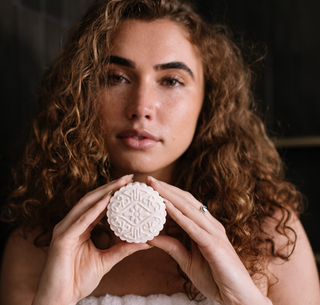In the ever-evolving world of sustainable and eco-friendly beauty products, conditioner bars have emerged as a game-changer. These compact, solid alternatives to liquid conditioners offer a multitude of benefits, from reducing plastic waste to providing nourishment for your hair. Let's delve into the secrets behind these conditioner bars and understand their benefits and effective usage.
Understanding Conditioner Bars
What Are Conditioner Bars?
Conditioner bars are solid, concentrated forms of conditioner typically made with natural ingredients like plant-based oils, butters, and essential oils. They come in various shapes and sizes and are activated by water during use.
Benefits of Using Conditioner Bars
Eco-Friendly
One of the primary advantages of conditioner bars is their eco-friendliness. Unlike traditional bottled conditioners that often come in plastic packaging, conditioner bars are usually packaged in minimal or plastic-free materials, reducing environmental waste.
Travel-Friendly
Their solid form makes them an ideal travel companion. You won't have to worry about leaks or adhering to liquid limits during flights. Plus, they take up minimal space in your luggage.
Longevity
Conditioner bars are highly concentrated, which means a little goes a long way. They tend to last longer than their liquid counterparts, making them cost-effective in the long run.
Natural Ingredients
Most conditioner bars are crafted using natural ingredients, free from harsh chemicals and additives. This makes them suitable for various hair types, including sensitive scalps.
How to Use Conditioner Bars Effectively
Step 1: Wet Your Hair
Begin by thoroughly wetting your hair. Conditioner bars work best when your hair is wet as it helps in the distribution of the product.
Step 2: Rub the Conditioner Bar
Rub the conditioner bar between your hands or directly onto your hair. Some prefer to apply it directly to their strands, while others like to rub it between their palms to create a creamy lather.
Step 3: Apply to Hair
Gently massage the conditioner into your hair, focusing on the ends, which tend to be drier. Allow the conditioner to sit for a minute or two to let the ingredients penetrate the strands.
Step 4: Rinse
Thoroughly rinse your hair until all the conditioner is washed out. You might need slightly more water than usual to ensure complete removal.
Tips for Maximizing the Benefits
Store Properly: Keep your conditioner bar in a dry area between uses to prevent it from dissolving too quickly.
Experiment: Some conditioner bars might work better for certain hair types. Don’t hesitate to try different brands or formulations to find the one that suits your hair best.
Transition Period: If you're switching from traditional liquid conditioners to bars, there might be an adjustment period for your hair. Give it a few uses to adapt.
Conclusion:
Conditioner bars are a sustainable, effective, and convenient alternative to traditional bottled conditioners. Their eco-friendly nature, long-lasting properties, and use of natural ingredients make them a compelling choice for those seeking a more conscious hair care routine.
Understanding Conditioner Bars
What Are Conditioner Bars?
Conditioner bars are solid, concentrated forms of conditioner typically made with natural ingredients like plant-based oils, butters, and essential oils. They come in various shapes and sizes and are activated by water during use.
Benefits of Using Conditioner Bars
Eco-Friendly
One of the primary advantages of conditioner bars is their eco-friendliness. Unlike traditional bottled conditioners that often come in plastic packaging, conditioner bars are usually packaged in minimal or plastic-free materials, reducing environmental waste.
Travel-Friendly
Their solid form makes them an ideal travel companion. You won't have to worry about leaks or adhering to liquid limits during flights. Plus, they take up minimal space in your luggage.
Longevity
Conditioner bars are highly concentrated, which means a little goes a long way. They tend to last longer than their liquid counterparts, making them cost-effective in the long run.
Natural Ingredients
Most conditioner bars are crafted using natural ingredients, free from harsh chemicals and additives. This makes them suitable for various hair types, including sensitive scalps.
How to Use Conditioner Bars Effectively
Step 1: Wet Your Hair
Begin by thoroughly wetting your hair. Conditioner bars work best when your hair is wet as it helps in the distribution of the product.
Step 2: Rub the Conditioner Bar
Rub the conditioner bar between your hands or directly onto your hair. Some prefer to apply it directly to their strands, while others like to rub it between their palms to create a creamy lather.
Step 3: Apply to Hair
Gently massage the conditioner into your hair, focusing on the ends, which tend to be drier. Allow the conditioner to sit for a minute or two to let the ingredients penetrate the strands.
Step 4: Rinse
Thoroughly rinse your hair until all the conditioner is washed out. You might need slightly more water than usual to ensure complete removal.
Tips for Maximizing the Benefits
Store Properly: Keep your conditioner bar in a dry area between uses to prevent it from dissolving too quickly.
Experiment: Some conditioner bars might work better for certain hair types. Don’t hesitate to try different brands or formulations to find the one that suits your hair best.
Transition Period: If you're switching from traditional liquid conditioners to bars, there might be an adjustment period for your hair. Give it a few uses to adapt.
Conclusion:
Conditioner bars are a sustainable, effective, and convenient alternative to traditional bottled conditioners. Their eco-friendly nature, long-lasting properties, and use of natural ingredients make them a compelling choice for those seeking a more conscious hair care routine.

